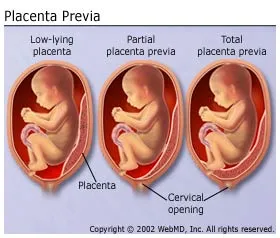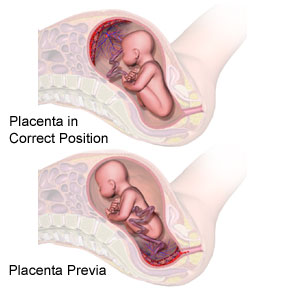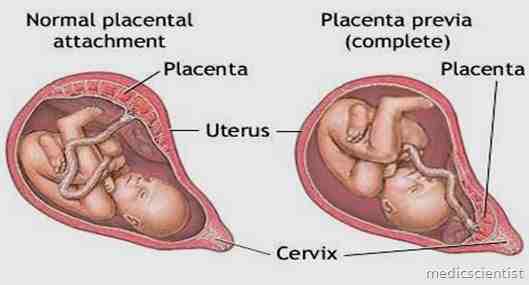 “It didn’t hit me that this could potentially be problematic,”
Courtney Nowak, of Staten Island, NY remembers thinking. She had just
had a routine sonogram at 13 weeks and her doctor had drawn her a
picture to show her that her placenta wasn’t where it should be— it was
now covering her cervix. She told Nowak that the condition, placenta
previa, was common, it was nothing to worry about. As the pregnancy
progressed, the placenta could move, she assured her.
“It didn’t hit me that this could potentially be problematic,”
Courtney Nowak, of Staten Island, NY remembers thinking. She had just
had a routine sonogram at 13 weeks and her doctor had drawn her a
picture to show her that her placenta wasn’t where it should be— it was
now covering her cervix. She told Nowak that the condition, placenta
previa, was common, it was nothing to worry about. As the pregnancy
progressed, the placenta could move, she assured her.Nevertheless, Nowak was told to avoid heavy lifting, vigorous exercise and sexual intercourse. And if she had any bleeding or pain, she had to call her doctor immediately.
After researching the condition, Nowak became a little nervous, especially since she was over 35 and already considered high-risk.
“I was aware that things could happen,” she said.

Fortunately, at her 30-week sonogram, Nowak and her husband found out her placenta had moved. And five months ago, Nowak gave birth to a healthy baby girl.
What is placenta previa?
One out of 200 pregnancies are affected by placenta previa, a condition in which the placenta covers part or all of the opening of the cervix , according to Dr. James Bernasko, an OB/GYN in the division of maternal-fetal medicine at Stony Brook University Hospital in New York.
 “When you have a placenta that’s lying over the cervix or very close
to the cervix when labor begins, it can cause a lot of bleeding and that
endangers the health and sometimes the life of the fetus and the
mother,” he said.
“When you have a placenta that’s lying over the cervix or very close
to the cervix when labor begins, it can cause a lot of bleeding and that
endangers the health and sometimes the life of the fetus and the
mother,” he said.What’s more, a recent study in the journal Obstetrics & Gynecology found that women with placenta previa who had previous births had a two-fold increased chance of delivering a low birth weight baby.
Experts aren’t sure why placenta previa occurs, although one theory is that upon implantation, the embryo tries to go to a part of the uterus where it thinks it will get the most nourishment. For example, if there is a scar in the uterus or the blood supply isn’t optimal, the embryo will implant somewhere else.
Sometimes that somewhere else may be close to the cervix,” Bernasko said.
Risk factors for placenta previa include:
 • Smoking (before pregnancy or during)
• Smoking (before pregnancy or during)• Maternal age (over 40)
• Abnormally shaped uterus
• Several previous pregnancies
• African American or Asian American race
• Cocaine use
• Previous pregnancy with placenta previa
• One or more previous cesarean sections
• Uterine surgery or abortion
Placenta previa is usually diagnosed at the 20-week sonogram, and since many women can have a “silent” placenta previa— one without any bleeding— women should have regular sonograms, Bernasko said.
The good news is that the placenta usually moves upward as the pregnancy progresses and about 90 percent of placenta previa cases will resolve by the time the woman is full term.
 In women who have no bleeding, some providers will say it’s not
necessary to make any changes. Other doctors may advise women avoid
strenuous activity, exercise and sexual intercourse, or order bed rest.
In women who have no bleeding, some providers will say it’s not
necessary to make any changes. Other doctors may advise women avoid
strenuous activity, exercise and sexual intercourse, or order bed rest.“The recommendations that providers give vary considerably,” Bernasko said.
If you have bleeding, your provider will likely put you on bed rest. If the bleeding stops, you may either have to restrict your activity or be on bed rest at home or in the hospital, depending on how heavy the bleeding was.
 If your pregnancy is at 37 weeks or more and you have very heavy
bleeding, your provider will recommend a C-section. If it’s earlier than
37 weeks and the bleeding is life-threatening to you or your baby, a
C-section is necessary as well.
If your pregnancy is at 37 weeks or more and you have very heavy
bleeding, your provider will recommend a C-section. If it’s earlier than
37 weeks and the bleeding is life-threatening to you or your baby, a
C-section is necessary as well.However, most providers will recommend a C-section at 37 weeks and would prefer that you don’t wait until your due date to do so— as you get closer, you’re more likely to go into labor on your own, which could turn into an emergency.
 “It may be a bit of cautious recommendation, but it’s only because we
don’t know exactly when the woman’s going to go into labor,” Bernasko
said.
“It may be a bit of cautious recommendation, but it’s only because we
don’t know exactly when the woman’s going to go into labor,” Bernasko
said.Julie Revelant is a freelance writer and copywriter specializing in parenting, health, healthcare, nutrition, food and women's issues. She’s also a mom of two. Learn more about Julie at revelantwriting.com.